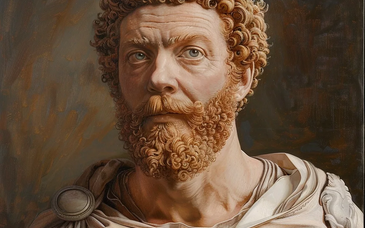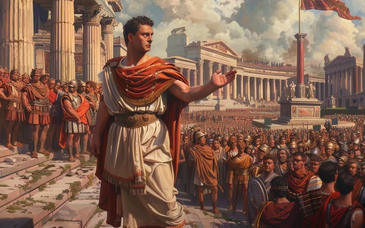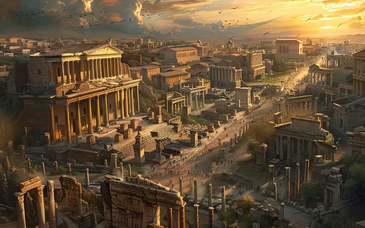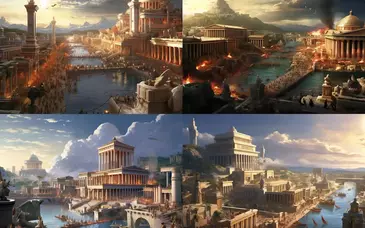Lectures
- The Geography of Italy
- The Etruscans
- The Roman Republic
- Roman Expansion and the Punic Wars
- The Civil War
- The Rise of Julius Casear
Instructional Goal: Students will know the major facts reference the Punic Wars and understand the implications of Roman expansion on the future Roman Empire.
I. Rome quickly expanded its influence far beyond the traditional Italian peninsula.
- By 300 BC Rome controlled all the city-states south of the Rubicon river.
- Sicily and Sardinia were conquered in 285 BC.
- Pyrrhic War (281-275) arose over a conflict between Rome and King Pyrrhus of Epirus, located on the eastern edge of the Adriatic sea. Pyrrhus actually won the war but at such great cost that he was forced to retreat (Pyrrhic victory).
- All of the Italian peninsula was controlled by Rome by 265 BC.
II. Rome began to expand its borders and came into conflict with Carthage.
- Carthage, located on the northern edge of Africa directly across from Sicily, had become an important force in the Mediterranean basin.
- Carthage was a former colony of Phoenicia.
- By 285 BC Carthage controlled most of north Africa, Spain and southern France.
- Carthage begin to feel threatened when Rome challenged its large commerical trade.
- Carthage considered the Mediterranean a "Carthaginian Lake."
- Conflict arose over a Carthaginian colony located on Sicily.
- Neither side attempted to avoid war.
III. The First Punic War (264-241 BC).
- Rome had certain advantages; (A) Strong army; (B) Easily defensable lands; (C) Loyalty of its subjects; (D) Generals who adapted as the war progressed.
- Carthage also had certain advantages; (A) Controlled the seas; (B) Controlled large land area; (C) Had a large population from which to recruit an army; (D) Generals were innovative and dynamic.
- A military stalemate developed early with neither side having a decisive edge.
- Rome finally captured a Carthaginian ship and copied its design.
- Rome built a fleet of warships within three months and adapted land tactics to them including; (A) Landing bridges; (B) Catapults (C) Grappling hooks.
- Rome finally defeated Carthage's navy and Carthage sued for peace in 241.
IV. During the intercession period of 241-219 BC Rome continued to expand its colonial holdings in the Mediterranean sea.
- Corsica was taken.
- Kingdom of Illyria in present-day Albania was annexed.
- Area north of the Po river known as Cisalpine Gaul was conquered.
- With its colonial holdings threatened Carthage decided to resume the war.
V. The Second Punic War (218-201 BC).
- A new general, Hannibal, led the Carthaginian war effort.
- Hannibal is remembered as one of the most innovative and dynamic military leaders in world history.
- He developed a plan to mount a surprise attack on Rome during the winter.
- He assembled a large army in Spain and marched across southern France and into the Italian Alps in the dead of winter.
- Although losing over 1/2 of his army he still entered the Po valley with a large army of 25,000 troops.
- He also had a detachment of armored elephants which were unique in European military history.
- Hannibal's attack surprised the Roman army and he easily defeated them in several battles.
- Rome, led by the general Fabian, made a decision to hide behind its walled cities (Fabian tactic) and leave the countryside to Hannibal.
- Rome finally decided to confront Hannibal head-on and met him at the Battle of Cannae in 216 BC.
- This battle was the most lop-sided in military history with Rome losing over 40,000 troops in a single morning.
- Rome again retreated behind its walled cities and Hannibal continued to have free reign over the country-side although a lack of supplies kept him defeating the Roman army.
- Rome finally decided to take the war directly to Carthage and led by a young general, Scipio Africanus, they defeated Hannibal in the Battle of Zama in 201 BC.
- Carthage lost all of its colonies and retained only the city-state itself.
VI. The Second intercession and third Punic War (201-146 BC);
- Rome continued to expand its colonies annexing Macedonia, Greece, Spain and Anatolia.
- Rome leaders, led by Senator Cato the Elder, wanted revenge upon Carthage and demanded its destruction.
- In 149 BC a punitive expedition destroyed the city of Carthage, with its walls being torn down, the ground plowed and salted.
- The present-day site of Carthage in Libya is still revered and considered a sacred spot by most north Africans.
Assignment: Students will read "Hannibal crossing the Alps" and the "Battle of Cannae".





